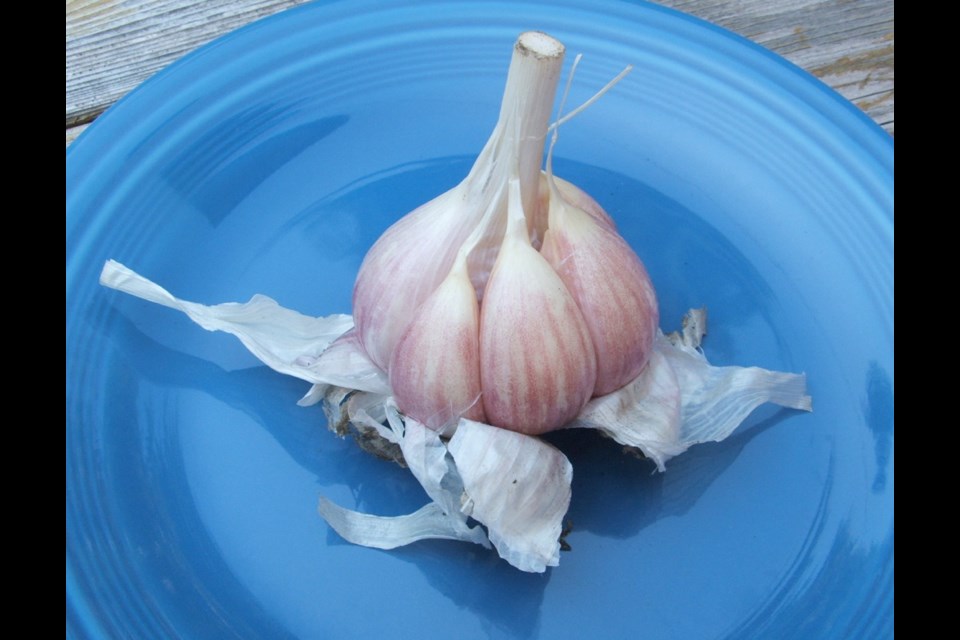It’s been a very different spring and summer this year, as a crippling knee injury has enforced regular intervals of rest between gardening sessions — times to stop and pamper the knee with cold compresses. Even when all has returned to normal I think I’ll keep the habit of taking breaks. They can be a source of delight.
One day recently I sat in blessed repose under the plum tree, taking in the view of the centre path into the vegetable garden, where a line of staking tomatoes growing against wire fencing was bordered by bush beans along the left-hand path edge.
Calendulas in bloom edged the right-side plot, along with a tall parsley plant flowering and setting seed for a new generation of young plants. A sprinkler was producing a gentle spray on a new kale planting.
Suddenly, a hummingbird flew into the scene, drawn I think by the water. The little bird seemed to swirl and dance in the light spray, darting off sporadically to visit nearby flowers. It was a magic show, put on by one of the garden’s most fascinating visitors.
Garlic harvest. Last month’s garlic harvest was the best ever in my garden, and I’m hearing that it has been generally an excellent garlic year. The unusual harvest was not surprising, considering the plants’ exceptionally strong growth.
The variety that routinely does best for me is Porcelain, also called Music, with Red Russian a close second. Music produces large bulbs, each holding around six big, elegantly plum-streaked cloves that are pleasingly juicy, with a robust flavour.
I was a little alarmed at digging an initial, test bulb at a corner of the Porcelain patch. The bulb was a hefty 7.5 cm in width, but it held only four enormous cloves, each one too much for flavouring a vinaigrette. They were, however, perfect for roasting. I steamed them soft with peeled potatoes and mashed the garlic and potato together with butter, salt and sour cream for a zesty side dish of garlicky mashed potato to accompany roast chicken for dinner. Garden beans and carrots rounded out the meal.
Fortunately, the rest of the harvested Porcelain bulbs held the more typical six or more reasonably sized cloves.
Porcelain (Music) and Red Russian, like most of the garlic commonly grown in home gardens, is a “hardneck” type, which forms bulbs that have a hard stalk surrounded by large, wedge-shaped, easily peeled cloves. The plants produce curled flower spikes, called “scapes,” in June. The scapes should be removed while they are young, and used in salads and stir-fry dishes.
“Softneck” garlic does not produce a flower spike and is preferred for braiding. The cloves are smaller and more variable.
As we savour and indulge in fresh, juicy, newly harvested garlic, it’s not a bad idea to decide where the next planting, best done mid-September to mid-October, is to be planted. I look for an area at an edge of a plot where it will be easy to avoid watering once the plants begin to dry off and the bulbs head into their final maturing stage in late June.
A reader’s warning. David has written with a request that I pass along a warning, following a less than happy experience in a strawberry planting.
“This spring, I took your suggestion with respect to strawberries and put in 90 of the Totem variety and they are growing beautifully. I dutifully pulled off all the blossoms (but cheated and left just enough to make one very small shortcake) and am looking forward to a jam making session next June.
“My one great annoyance, however, was caused by my foolish application, when preparing the bed for planting, of under-decayed horse manure, which has produced a great many weeds I’ve never seen before. Most prevalent is portulaca.
“Please warn your readers not to use horse manure unless it is very, very well rotted.”



